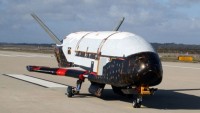Clandestine X-37B Spaceplane Returns to Earth after Record 718 Days in Orbit
| Arthur Dominic Villasanta | | May 08, 2017 09:09 AM EDT |
(Photo : USAF) The X-37B Orbital Test Vehicle mission 4 (OTV-4) after landing at NASA's Kennedy Space Center Shuttle Landing Facility in Cape Canaveral, Florida on May 7.
The clandestine U.S. Air Force X-37B spaceplane finally landed on May 7 after a record-setting 718 days orbiting the Earth but no one except the air force knows exactly what this mini-Space Shuttle did up there apart from spying on the United States' strategic competitors.
This X-37B mission -- which was called OTV-4 -- entered the record books on March 25 by breaking the world space endurance record by a spaceplane.
Like Us on Facebook
While ostensibly a platform to test "reusable spacecraft technologies for America's future in space," the X-37B is a sophisticated spy spaceplane that's been equipped with high-resolution cameras on all its four missions.
OTV-4 exceeded the current record of 674 days in orbit to reach 675 days on March 25. The previous record for the longest time spent orbiting the Earth by a spaceplane capable of a return flight was set by the OTV-3 mission.
OTV-4 announced its landing at the Kennedy Space Center in Cape Canaveral in Florida with a piercing sonic boom that shook buildings and windows in central Florida and could be heard as far away as Tampa and Fort Myers.
In a terse statement, the air force said the X-37B spacecraft program is "an experimental test program to demonstrate technologies for a reliable, reusable, unmanned space test platform."
The air force, however, announced a fifth mission for the X-37B will launch within the year.
OTV-4 blasted-off from Cape Canaveral Air Force Station in Florida on May 20, 2015 aboard a United Launch Alliance Atlas V rocket. As with the previous three OTV missions, the Air Force remained tight-lipped about the true purpose of the OTV-4 mission.
The previous X-37B record of 674 days in space was set by OTV-3, which blasted-off from Cape Canaveral Air Force Station on December 12, 2012 and landed at Vandenberg Air Force Base on October 17, 2014.
The air force said OTV-4 tested a prototype "Hall Effect Thruster" (HET) in support of its Advanced Extremely High Frequency (AEHF) communications satellite program. This new propulsion system will utilize xenon gas in order to produce a small thrust that maintains satellites in lower Earth orbit.
The U.S. Department of Defense said operational Hall Effect Thrusters or Hall Thrusters will propel U.S. military satellites in Earth orbit or power future spacecraft on interplanetary voyages.
OTV also carried experimental payloads such as the Materials Exposure and Technology Innovation in Space (Metis), which exposed 100 material samples measuring about an inch in diameter to dangerous and harsh space conditions. This test determined how various materials can withstand extreme temperatures in a vacuum environment.
OTV-4 also carried the LightSail project by The Planetary Society, which is the first test flight for the small spacecraft with sails that will use solar energy to glide through space.
TagsX-37B spaceplane, OTV-4, U.S. Air Force, spaceplane, 718 days, Hall Effect Thruster, Materials Exposure and Technology Innovation in Space, LightSail project
©2015 Chinatopix All rights reserved. Do not reproduce without permission
EDITOR'S PICKS
-

Did the Trump administration just announce plans for a trade war with ‘hostile’ China and Russia?
-

US Senate passes Taiwan travel bill slammed by China
-

As Yan Sihong’s family grieves, here are other Chinese students who went missing abroad. Some have never been found
-

Beijing blasts Western critics who ‘smear China’ with the term sharp power
-

China Envoy Seeks to Defuse Tensions With U.S. as a Trade War Brews
-

Singapore's Deputy PM Provides Bitcoin Vote of Confidence Amid China's Blanket Bans
-

China warns investors over risks in overseas virtual currency trading
-

Chinese government most trustworthy: survey
-

Kashima Antlers On Course For Back-To-Back Titles
MOST POPULAR
LATEST NEWS
Zhou Yongkang: China's Former Security Chief Sentenced to Life in Prison

China's former Chief of the Ministry of Public Security, Zhou Yongkang, has been given a life sentence after he was found guilty of abusing his office, bribery and deliberately ... Full Article
TRENDING STORY

China Pork Prices Expected to Stabilize As The Supplies Recover

Elephone P9000 Smartphone is now on Sale on Amazon India

There's a Big Chance Cliffhangers Won't Still Be Resolved When Grey's Anatomy Season 13 Returns

Supreme Court Ruled on Samsung vs Apple Dispute for Patent Infringement

Microsoft Surface Pro 5 Rumors and Release Date: What is the Latest?











